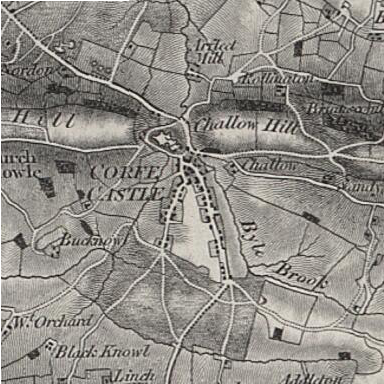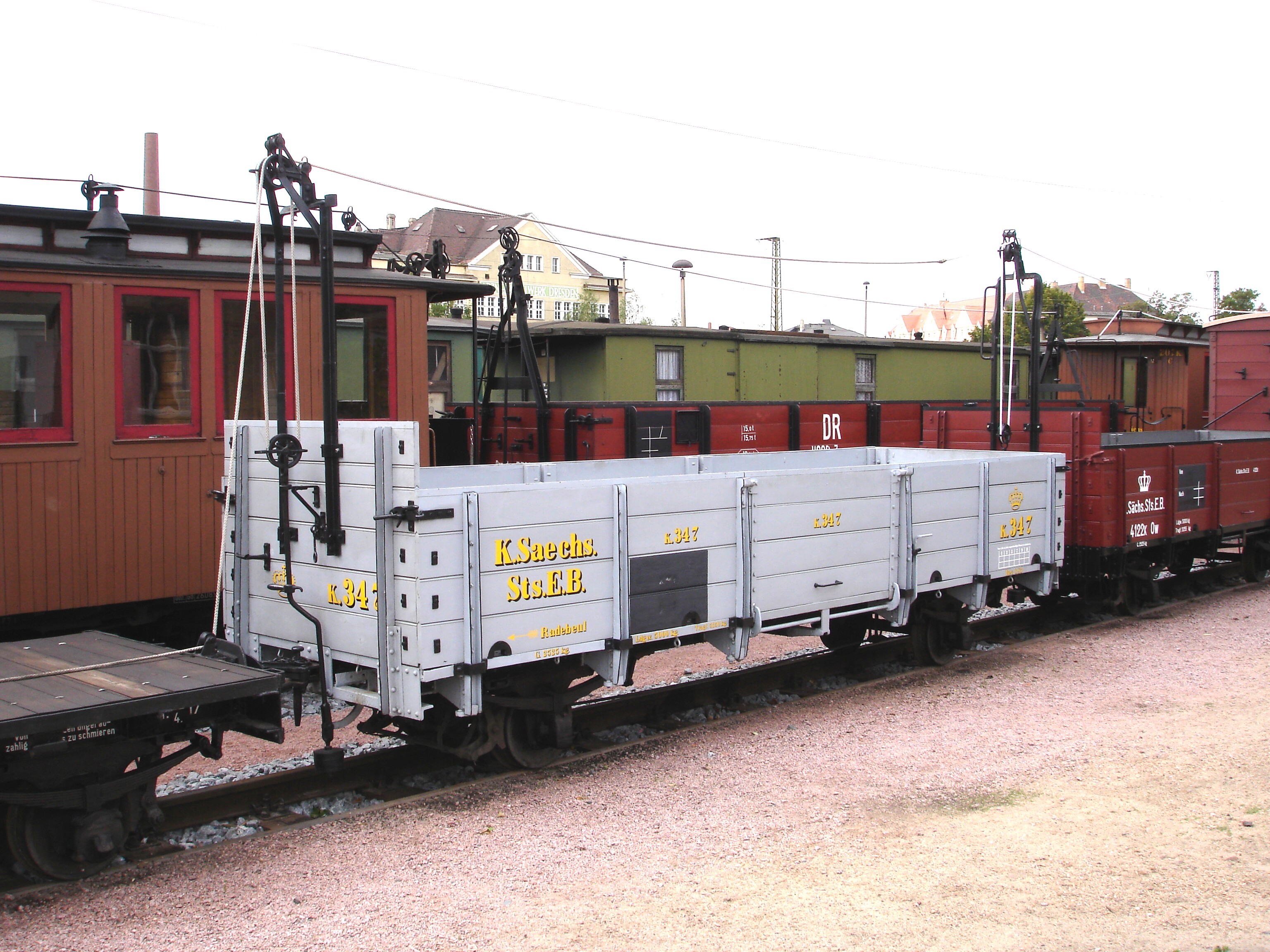|
Middlebere Plateway
The Middlebere Plateway, or Middlebere Tramway, was a horse-drawn plateway on the Isle of Purbeck in the England, English county of Dorset. One of the first railways in southern England and the first in Dorset, the plateway was built by Benjamin Fayle, who was a wealthy Irish Merchant based in London and a friend of Thomas Byerley - Josiah Wedgwood's nephew. It was intended to take Purbeck Ball Clay from his pits near Corfe Castle (village), Corfe Castle to a wharf on Middlebere Creek in Poole Harbour, a distance of some . History Near contemporary accounts indicate that the line was built in 1805 and opened in 1806, and it is present on a map of 1811. On 16 August 1806, Fayle wrote to Wedgwood announcing the opening of the line and a reduction in the price of clay. The engineer was John Hodgkinson, who had worked with his cousin Benjamin Outram, a pioneering railway and canal engineer. Papers held in Corfe Castle Town Museum state that the contractor was named Willis. At the ti ... [...More Info...] [...Related Items...] OR: [Wikipedia] [Google] [Baidu] |
Corfe Castle (village)
Corfe Castle is a village and civil parish in the English county of Dorset. It is the site of a ruined castle of the same name. The village and castle stand over a gap in the Purbeck Hills on the route between Wareham and Swanage. The village lies in the gap below the castle and is around south-east of Wareham, and north-northwest of Swanage. Both the main A351 road from Lytchett Minster to Swanage and the Swanage Railway thread their way through the gap and the village. The civil parish of Corfe Castle stretches across the width of the Isle of Purbeck, with coasts facing both the English Channel and Poole Harbour. It, therefore, includes sections of both the low-lying sandy heathland that lies to the north of the castle and the rugged Jurassic Coast upland to the south. History Burial mounds around the common of Corfe Castle suggest that the area was occupied from 6000 BC. The common also points to a later Celtic field system worked by the Durotriges tribe. Evidence ... [...More Info...] [...Related Items...] OR: [Wikipedia] [Google] [Baidu] |
Tunnel
A tunnel is an underground passageway, dug through surrounding soil, earth or rock, and enclosed except for the entrance and exit, commonly at each end. A pipeline is not a tunnel, though some recent tunnels have used immersed tube construction techniques rather than traditional tunnel boring methods. A tunnel may be for foot or vehicular road traffic, for rail traffic, or for a canal. The central portions of a rapid transit network are usually in the tunnel. Some tunnels are used as sewers or aqueducts to supply water for consumption or for hydroelectric stations. Utility tunnels are used for routing steam, chilled water, electrical power or telecommunication cables, as well as connecting buildings for convenient passage of people and equipment. Secret tunnels are built for military purposes, or by civilians for smuggling of weapons, contraband, or people. Special tunnels, such as wildlife crossings, are built to allow wildlife to cross human-made barriers safely. ... [...More Info...] [...Related Items...] OR: [Wikipedia] [Google] [Baidu] |
Norden Railway Station (Dorset)
Norden railway station is a railway station located one mile to the north of the village of Corfe Castle, on the Isle of Purbeck in the English county of Dorset. It is situated on the Swanage Railway, a heritage railway that operates over the former London and South Western Railway line from Wareham to Swanage. Norden is the northern terminus of the railway's steam service from Swanage, and an intermediate stop on the railway's diesel hauled service that connects Swanage with the national rail network at Wareham station. The site is the home of the Purbeck Mineral and Mining Museum, a museum about the history of ball clay mining in the Isle of Purbeck. The museum includes the relocated header building of one of the areas last underground mines, together with a reconstruction of an underground gallery. There is also a section of the narrow gauge railway that served the clay industry, and a collection of narrow gauge rolling stock. A large car park, provided by Purbeck District ... [...More Info...] [...Related Items...] OR: [Wikipedia] [Google] [Baidu] |
Listed Building
In the United Kingdom, a listed building or listed structure is one that has been placed on one of the four statutory lists maintained by Historic England in England, Historic Environment Scotland in Scotland, in Wales, and the Northern Ireland Environment Agency in Northern Ireland. The term has also been used in the Republic of Ireland, where buildings are protected under the Planning and Development Act 2000. The statutory term in Ireland is " protected structure". A listed building may not be demolished, extended, or altered without special permission from the local planning authority, which typically consults the relevant central government agency, particularly for significant alterations to the more notable listed buildings. In England and Wales, a national amenity society must be notified of any work to a listed building which involves any element of demolition. Exemption from secular listed building control is provided for some buildings in current use for worship, ... [...More Info...] [...Related Items...] OR: [Wikipedia] [Google] [Baidu] |
Cast Iron
Cast iron is a class of iron–carbon alloys with a carbon content more than 2%. Its usefulness derives from its relatively low melting temperature. The alloy constituents affect its color when fractured: white cast iron has carbide impurities which allow cracks to pass straight through, grey cast iron has graphite flakes which deflect a passing crack and initiate countless new cracks as the material breaks, and ductile cast iron has spherical graphite "nodules" which stop the crack from further progressing. Carbon (C), ranging from 1.8 to 4 wt%, and silicon (Si), 1–3 wt%, are the main alloying elements of cast iron. Iron alloys with lower carbon content are known as steel. Cast iron tends to be brittle, except for malleable cast irons. With its relatively low melting point, good fluidity, castability, excellent machinability, resistance to deformation and wear resistance, cast irons have become an engineering material with a wide range of applications and are ... [...More Info...] [...Related Items...] OR: [Wikipedia] [Google] [Baidu] |
Level Crossing
A level crossing is an intersection where a railway line crosses a road, Trail, path, or (in rare situations) airport runway, at the same level, as opposed to the railway line crossing over or under using an Overpass#Railway, overpass or tunnel. The term also applies when a light rail line with separate Right-of-way (railroad), right-of-way or reserved track crosses a road in the same fashion. Other names include railway level crossing, railway crossing (chiefly international), grade crossing or railroad crossing (chiefly American), road through railroad, criss-cross, train crossing, and RXR (abbreviated). There are more than 100,000 level crossings in Europe and more than 200,000 in North America. History The history of level crossings depends on the location, but often early level crossings had a Flagman (rail), flagman in a nearby booth who would, on the approach of a train, wave a red flag or lantern to stop all traffic and clear the tracks. Gated crossings bec ... [...More Info...] [...Related Items...] OR: [Wikipedia] [Google] [Baidu] |
Open Wagon
Open wagons (trucks in the UK) form a large group of railway goods wagons designed primarily for the transportation of bulk goods that are not moisture-retentive and can usually be tipped, dumped or shovelled. The International Union of Railways (UIC) distinguishes between ordinary wagons (Class E/ UIC-type 5) and special wagons (F/6). Open wagons often form a significant part of a railway company's goods wagon fleet; for example, forming just under 40% of the Deutsche Bahn's total goods wagon stock in Germany. UIC standard goods wagons Since the 1960s, the majority of goods wagons procured by European railway administrations have been built to standards laid down by, or based on, those established by the UIC. In addition to open wagons the table also shows wagons with opening roofs (Class T), whose design is based on open wagons. File:El-Wagen-UIC-Bauart1-Zittau.jpg, Twin-axled UIC Type 1 open wagon, used as an ash wagon, on a transporter wagon in Zittau File:Es-Wa ... [...More Info...] [...Related Items...] OR: [Wikipedia] [Google] [Baidu] |
Clay Truck
A tub or quarry tub is a type of railway or tramway wagon used in quarries and other industrial locations for the transport of minerals (such as coal, sand, ore, clay and stone) from a quarry or mine face to processing plants or between various parts of an industrial site. This type of wagon may be small enough for one person to push, or designed for haulage by a horse, or for connection in a train hauled by a locomotive. The tubs are designed for ease of emptying, usually by a side-tipping action. This type of rail vehicle is now mainly obsolete, its function having been mostly replaced by conveyor belts. See also * British narrow gauge railways * Chaldron * Corf * Mine car * Minecart * Mineral wagon * Mine railway A mine railway (or mine railroad, U.S.), sometimes pit railway, is a railway constructed to carry materials and workers in and out of a mine. Materials transported typically include ore, coal and overburden (also called variously spoils, waste, ... Refe ... [...More Info...] [...Related Items...] OR: [Wikipedia] [Google] [Baidu] |
London And South Western Railway
The London and South Western Railway (LSWR, sometimes written L&SWR) was a railway company in England from 1838 to 1922. Originating as the London and Southampton Railway, its network extended to Dorchester and Weymouth, to Salisbury, Exeter and Plymouth, and to Padstow, Ilfracombe and Bude. It developed a network of routes in Hampshire, Surrey and Berkshire, including Portsmouth and Reading. The LSWR became famous for its express passenger trains to Bournemouth and Weymouth, and to Devon and Cornwall. Nearer London it developed a dense suburban network and was pioneering in the introduction of a widespread suburban electrified passenger network. It was the prime mover of the development of Southampton Docks, which became an important ocean terminal as well as a harbour for cross channel services and for Isle of Wight ferries. Although the LSWR's area of influence was not the home of large-scale heavy industry, the transport goods and mineral traffic was a major activity, a ... [...More Info...] [...Related Items...] OR: [Wikipedia] [Google] [Baidu] |
Swanage
Swanage () is a coastal town and civil parish in the south east of Dorset, England. It is at the eastern end of the Isle of Purbeck and one of its two towns, approximately south of Poole and east of Dorchester. In the 2011 census the civil parish had a population of 9,601. Nearby are Ballard Down and Old Harry Rocks, with Studland Bay and Poole Harbour to the north. Within the parish are Durlston Bay and Durlston Country Park to the south of the town. The parish also includes the areas of Herston, just to the west of the town, and Durlston, just to the south. The town, originally a small port and fishing village, flourished in the Victorian era, when it first became a significant quarrying port and later a seaside resort for the rich of the day. Today the town remains a popular tourist resort, this being the town's primary industry, with many thousands of visitors coming to the town during the peak summer season, drawn by the bay's sandy beaches and other attractions. Duri ... [...More Info...] [...Related Items...] OR: [Wikipedia] [Google] [Baidu] |





